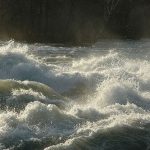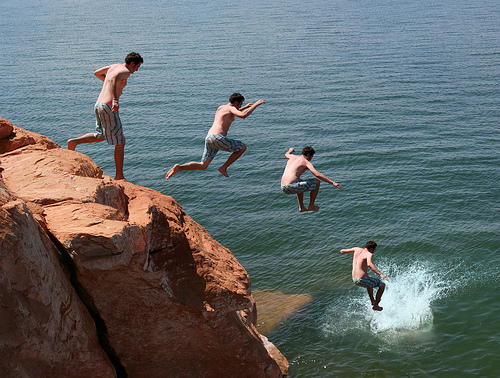A Series of Shots for Quick Action
In our exploration of stationary camera shots, we’re now going to take a look at another commonly used camera directive: a Series of Shots. Some think a Series of Shots is the same thing as a Montage, but it’s quite different. A Series of Shots is just that—a series of consecutive shots but in immediacy. This camera technique is used mostly for fast action.
You might have a high action scene in your novel and your Series of Shots could look like this:
- Car screeches around a tight curve on the treacherous mountain road
- Driver reaches over and tries to strangle the woman passenger sitting next to him
- Passenger door flings open and the woman jumps out of the car
- Driver quickly wrenches the wheel to avoid going off the cliff
- Woman tumbles down the hill
- Car skids out, careens into the hillside, and explodes
When writing fast-action or high-suspense moments, writers are encouraged to use short words, sentences, and paragraphs. Take a look at a few suspense novels or action-thrillers and see how great writers do this. Writing in this clipped style gives a sense of urgency and makes time move quickly. The reader reads fast, and that helps the pacing feel fast. Superfluous words are cut; lines of explanation or backstory are omitted. Every word counts.
A Lot Happens in a Short Period of Time
In one of my favorite novels, Shibumi, by Trevanian, we see a terrifically tense scene deftly woven with the use of a Series of Shots camera technique. Hel finds himself trapped in an underground cavern where he and his close friend le Cagot were spelunking. The bad guys have not only killed his friend but sealed the only exit out of the cave. Hel’s only option is to venture madly into the underground river cutting through the “Wine Cellar” in the hopes it will suck him down and through to freedom outside the mountain.
But he has no idea if any navigable wide-enough egress exists. With his faceplate now cracked and his jaw broken from a fall, his last flare sputters out, throwing him into darkness that closes in on his mind “with a crushing weight.” Pay attention to how Trevanian uses these series of quick images, speeding up at the end of the passage as Hel’s desperation grows and his air diminishes.
Nothing in the world would be easier than to accept death with dignity, with shibumi . . .
He wedged the rubberized flashlight between two outcroppings of aragonite, and it its beam attached the mask to the air tank, grunting with pain as he tightened the connections with his flayed fingers. After carefully threading the straps over his bruised shoulder, he opened the inflow valve, then dipped up a little spit water to clear the faceplate of breath mist. The pressure of the mask against his broken jaw was painful, but he could manage it. . . .
He took a deep breath and braced his nerves, remembering how that current had snatched away the dye packets so quickly that the eye could not follow them.
Almost leisurely, his body floated toward the bottom of the sump pit. That was his last clear image.
The current gripped him, and he shot into the pipe. His foot hit something; the leg crumpled, the knee striking his chest; he was spinning; the flashlight was gone; he took a blow on the spine, another on the hip.
 And suddenly he was lodged behind a choke stone, and the water was roaring past him, tearing at him. The mask twisted, and the faceplate blew out, the broken pieces cutting his leg as they flashed past. He had been holding his breath from fear for several seconds, and the need for air was pounding in his temples. Water rushed over his face and eddied up his nostrils. It was the goddamned tank! He was wedged in there because the space was too narrow for both his body and the tank! He gripped his knife with all the force of his body focused on his right hand, as the water sought to twist the knife from his grasp. Had to cut away the tank! The weight of the current against the cylinder pressed the straps against his shoulders. No way to slip the knife under He must saw through the webbing directly against his chest.
And suddenly he was lodged behind a choke stone, and the water was roaring past him, tearing at him. The mask twisted, and the faceplate blew out, the broken pieces cutting his leg as they flashed past. He had been holding his breath from fear for several seconds, and the need for air was pounding in his temples. Water rushed over his face and eddied up his nostrils. It was the goddamned tank! He was wedged in there because the space was too narrow for both his body and the tank! He gripped his knife with all the force of his body focused on his right hand, as the water sought to twist the knife from his grasp. Had to cut away the tank! The weight of the current against the cylinder pressed the straps against his shoulders. No way to slip the knife under He must saw through the webbing directly against his chest.
White pain.
His pulse throbbed, expanding in his head. His throat convulsed for air. Cut harder! Cut, damn it!
The tank went, smashing his foot as it rushed out under him. He was moving again, twisting. The knife was gone. With a terrible crunching sound, something hit the back of his head. His diaphragm heaved within him, sucking for breath. His heartbeat hammered in his head as he tumbled and twisted in the chaos of foam and bubbles.
Bubbles . . . Foam! He could see! Swim up! Swim!
And that’s how the chapter ends, leaving the reader almost as breathless as Trevanian’s protagonist. Instead of lengthy paragraphs describing everything Hel sees and feels, Trevanian uses a Series of Shots to give a sense of quick movement, as one thing after another happens to his protagonist, until it feels like everything has been wrenched out of his control. A truly supercharged scene!
This week, think about your WIP and see if you can find a place for a Series of Shots. Do you have any high action in which you want things to speed by, from the perspective of your POV character? Any scene in which a lot of things are happening at once and you want the feel of them all converging or overlapping? See if you can create a Series of Shots for cinematic effect!












I’ve done a scene this way in my novel, covering a short period of fast action from various characters’ viewpoints — and one of the characters is a newsman working his camera. Sometimes he’s looking through the viewfinder, and the action is described in that limited view as he pans and zooms to record it.
The viewpoint jumps back and forth quickly between the characters in short bursts. It works great. Let me know if you’d like to see a slice of it.
This is a great look at a tense passage, thanks for posting it. I wrote a similar scene in which the heroine leaps from one platform to another, misses and is sucked into a hydroelectric plant intake.
My attempt (my first) was not bad but neither was as good as Trevanian’s. If I were to rewrite it now, I’d trim a few descriptive phrases and add those interior thoughts.
My WIP has a hurricane dropped on a hostage rescue team. I’ll refer to this when I get there. Thanks!
Peace, Seeley
Yes, it’s difficult to compose an action sequence with the written word. There’s the tendency to include a great deal of verbiage so as to make the scene more realistic to the reader, instead of providing a few critical words. On a side note, “Shibumi” is one of my favorite novels! I read it when it first came out in 1979 and am both surprised and disappointed that it’s never been made into a movie.
I often do manuscript reviews, some book doctoring, and advise writers who get reject slips or low sales on what needs to be fixed in their manuscripts.
You describe what is very often the problem. Too many writers want to build up to their tale and fail to grab their readers in the first few pages.
I tell them to watch an episode or two of CSI (any of them). They use an opening technique much like yours.
Good advice and great description of its use.